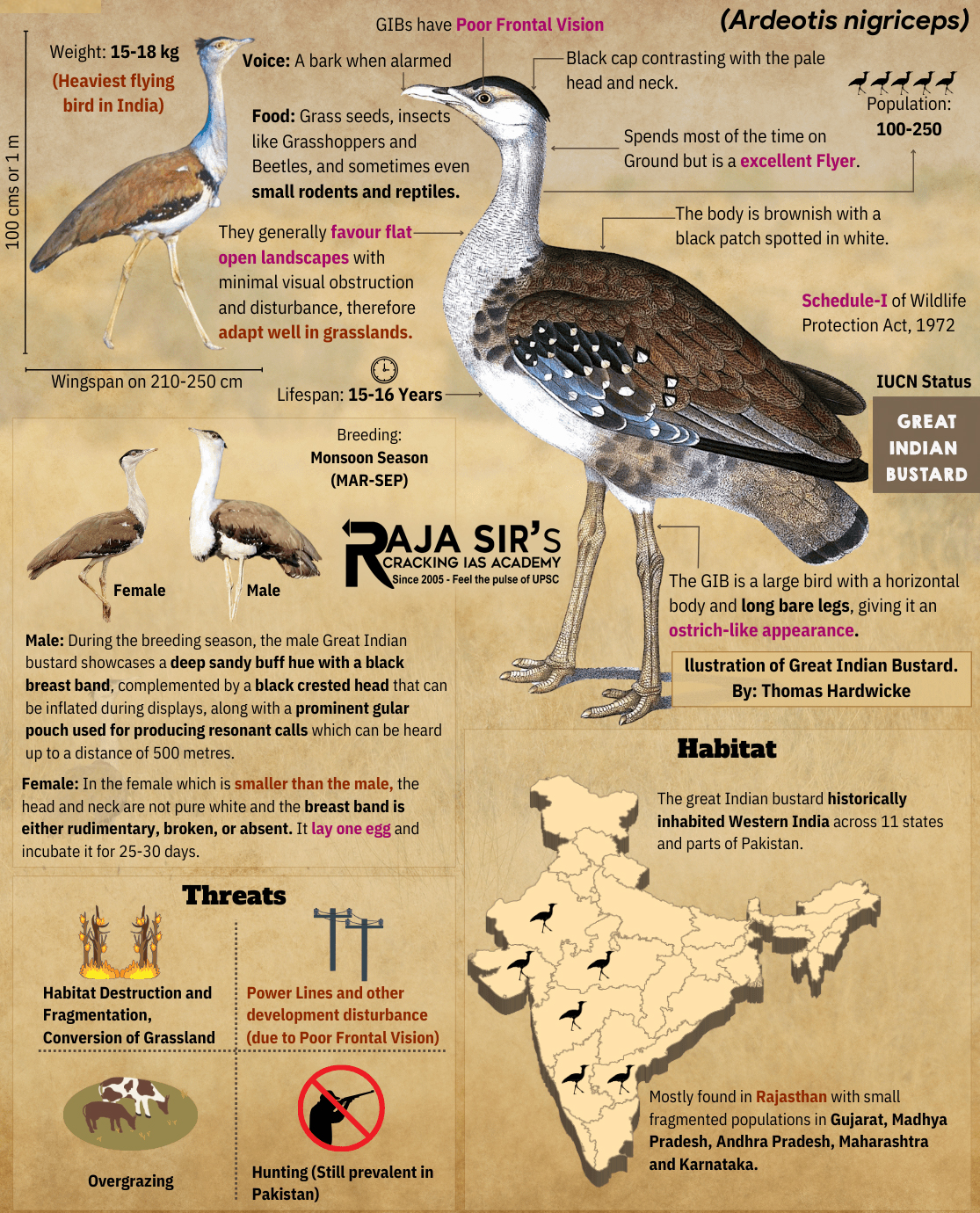- Home
- Prelims
- Mains
- Current Affairs
- Study Materials
- Test Series
 EDITORIALS & ARTICLES
EDITORIALS & ARTICLES
Great Indian Bustards
- The Great Indian Bustard (Ardeotis nigriceps), the State bird of Rajasthan, is considered India’s most critically endangered bird.
- It is considered the flagship grassland species, representing the health of the grassland ecology.
- Its population is confined mostly to Rajasthan and Gujarat. Small populations occur in Maharashtra, Karnataka and Andhra Pradesh.
- Vulnerability:
- The bird is under constant threats due to collision/electrocution with power transmission lines, hunting (still prevalent in Pakistan), habitat loss and alteration as a result of widespread agricultural expansion, etc.
- GIBs are a slow-reproducing species. They lay a few eggs and have almost a year-long parental care of chicks. The GIB achieves maturity in around 3-4 years.
- Protection Status:
- IUCN Red List: Critically Endangered
- Convention on International Trade in Endangered Species of Wild Fauna and Flora (CITES): Appendix 1
- Convention on Migratory Species (CMS): Appendix I
- Wildlife (Protection) Act, 1972: Schedule I
 Conserve the GIB
Conserve the GIB
- Species Recovery Programme:
- It is kept under the species recovery programme under the Integrated Development of Wildlife Habitats of the Ministry of Environment, Forests and Climate Change (MoEFCC).
- Firefly Bird Diverters:
- Firefly bird diverters are flaps installed on power lines. They work as reflectors for bird species like the GIB.
- Birds can spot them from a distance of about 50 meters and change their path of flight to avoid collision with power lines.
- Artificial Hatching:
- The conservation breeding programme started in 2019 by collecting eggs from the wild and artificially hatching them. The first chick hatched on 21st June 2019, and was named ‘Uno’. Eight more chicks were hatched that year and raised and monitored.
- A total of 29 GIBs have been housed in the two breeding centres in Rajasthan.
- National Bustard Recovery Plans:
- It is currently being implemented by conservation agencies.
- Conservation Breeding Facility:
- MoEF&CC, the Rajasthan government and the Wildlife Institute of India (WII) have also established a conservation breeding facility in Desert National Park at Jaisalmer in June 2019.
- Project Great Indian Bustard:
- It has been launched by the Rajasthan government to construct breeding enclosures for the species and develop infrastructure to reduce human pressure on its habitats.
Desert National Park:
- It is situated on the western border of India within the Jaisalmer & Barmer Districts of Rajasthan.
- Great Indian Bustards, Rajasthan State animal (Chinkara), State tree (khejri) and State flower (Rohida) are found naturally at this park.
- It was declared a UNESCO World Heritage Site in 1980 and National Park in 1992.
Kutch Bustard Sanctuary:
- The Kutch Bustard Sanctuary is located near Nalia in the Kutch district of Gujarat, India.
- It is the smallest sanctuary in the country, spread over just two square kilometres. The sanctuary, also known as the Lala-Parijan sanctuary, was declared in July 1992 primarily to safeguard the endangered Great Indian bustard.
- The sanctuary is home to three species of Bustards: the Great Indian bustard, lesser floricans, and the Macqueen bustard.









 Latest News
Latest News General Studies
General Studies